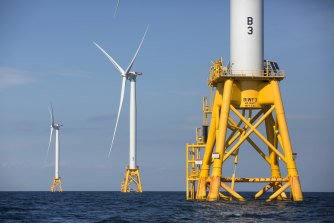Clean energy and regional blue collar jobs will be a target for both sides in the upcoming federal election, with the Coalition government asking for input on rules for building massive offshore wind farms that could power a manufacturing resurgence.
Assistant Energy and Emissions Reduction Minister Tim Wilson said the government wants to attract private investors in offshore wind farms for Australia to “realise the full opportunity of a lower carbon world”.
Australia to unveil rules around offshore wind projectsCredit:AP
The federal election is due in May. The government has dragged its heels on legalising offshore wind farms in Commonwealth waters – where turbines can be built far enough from land that they aren’t visible from shore.
After initially promising to enact laws by the middle of 2021, legislation was finally passed in November. Now the government is consulting stakeholders on the regulations needed to guide industry before construction kicks off.
“It’s absolutely an opportunity for communities that have had traditional fuels for energy to create opportunities in building Australia’s industrial future,” Mr Wilson said.
Energy Minister Angus Taylor said the regulations were an “important next step in supporting a new offshore industry” that would boost regional manufacturing.
“This will create a range of important new opportunities, particularly in our regions, by enhancing the delivery of affordable reliable power and creating thousands of new jobs,” Mr Taylor said.
Labor’s support for offshore wind to power regional industry preceded the Morrison government. Opposition Energy spokesman Chris Bowen in June wrote to Energy Minister Angus Taylor asking him to legalise offshore wind “matter of urgency” and warning of missed opportunities for jobs and investment.
Industry advocates say offshore wind can provide baseload-like power to regional industrial hubs. Beyond Zero Emission found that, based on modelling by ACIL Allen, massive offshore wind precincts at old industrial centres Newcastle and Gladstone could generate 45,000 new ongoing jobs by 2032 and generate $13 billion in annual revenue, with growth in green steel, hydrogen and cement manufacturing.
Earlier this month the Victorian government announced a target for offshore wind development to generate at least two gigawatts of energy, enough to power 1.5 million homes, by 2032.
Mr Wilson accused Labor, which has more ambitious targets for greenhouse emissions reduction, of seeking to “impose an electricity tax by stealth” – a reference to Labor’s more ambitious climate policy.
Labor has pledged to reduce Australia’s carbon pollution by 43 per cent over the next decade, starting from 2005 level of emissions, which is significantly higher than the government’s commitment to reduce emissions by at least 26 per cent.
The most controversial element of Labor’s emissions plan is its commitment to tighten limits on industrial polluters under the Safeguard Mechanism, which was established by the Coalition in 2016.
It currently applies to facilities that together generate 140 million tonnes of greenhouse gases a year, or 28 per cent of national emissions. Labor said it would drive down emissions to meet its tightening caps on carbon pollution each year, starting in 2023.
Industry groups that would be forced to reduce emissions under the safeguard mechanism, including aluminium, coal-fired power generation, cement, mining and gas production have backed Labor’s plan to tighten caps on their pollution.
Mr Taylor has dubbed Labor’s plan for the safeguard mechanism a “sneaky carbon tax” that would impose costs on industry that would be imposed on consumers.
Consultation on the offshore wind regulations is open until April 22.
A guide to the environment, what’s happening to it, what’s being done about it and what it means for the future. Sign up to our fortnightly Environment newsletter here.
Most Viewed in Politics
From our partners
Source: Read Full Article





